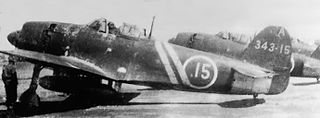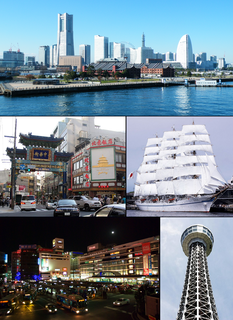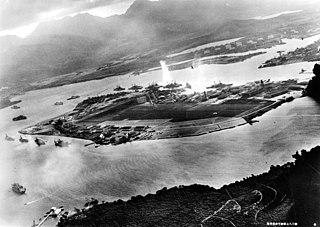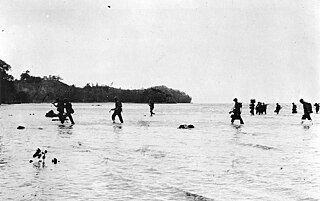
The Guadalcanal Campaign, also known as the Battle of Guadalcanal and codenamed Operation Watchtower by American forces, was a military campaign fought between 7 August 1942 and 9 February 1943 on and around the island of Guadalcanal in the Pacific theater of World War II. It was the first major offensive by Allied forces against the Empire of Japan.

The Battle of the Coral Sea, fought from 4 to 8 May 1942, was a major naval battle between the Imperial Japanese Navy (IJN) and naval and air forces from the United States and Australia, taking place in the Pacific Theatre of World War II. The battle is historically significant as the first action in which aircraft carriers engaged each other, as well as the first in which neither side's ships sighted nor fired directly upon the other.

The naval Battle of the Eastern Solomons, took place on 24–25 August 1942, and was the third carrier battle of the Pacific campaign of World War II and the second major engagement fought between the United States Navy and the Imperial Japanese Navy during the Guadalcanal Campaign. As at the Battle of the Coral Sea and the Battle of Midway, the ships of the two adversaries were never within sight of each other. Instead, all attacks were carried out by carrier-based or land-based aircraft.
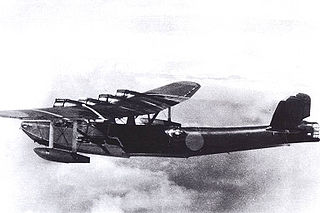
The Kawanishi H6K was an Imperial Japanese Navy flying boat produced by the Kawanishi Aircraft Company and used during World War II for maritime patrol duties. The Allied reporting name for the type was Mavis; the Navy designation was "Type 97 Large Flying Boat" (九七式大型飛行艇).

This is an order of battle for the Battle of the Coral Sea. The battle, fought during 4–8 May 1942, was a major naval battle in the Pacific Theater of World War II between the Imperial Japanese Navy and Allied naval and air forces from the United States (U.S.) and Australia.

The Nggela Islands, also known as the Florida Islands, are a small island group in the Central Province of Solomon Islands, a sovereign state in the southwest Pacific Ocean.

Cactus Air Force refers to the ensemble of Allied air power assigned to the island of Guadalcanal from August 1942 until December 1942 during the early stages of the Guadalcanal Campaign, particularly those operating from Henderson Field. The term "Cactus" comes from the Allied code name for the island. In 1943 the Cactus Air Force was subsumed into (AirSols), a joint command of Allied air units in the Solomon Islands.
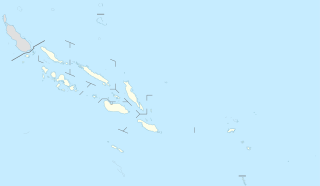
Gavutu is a small islet in the Central Province of the Solomon Islands, some 500 metres in length. It is one of the Nggela Islands.

Operation K was a Japanese naval operation in World War II, intended as a reconnaissance of Pearl Harbor and disruption of repair and salvage operations following the surprise attack on 7 December 1941. It culminated on 4 March 1942, with an unsuccessful attack carried out by two Kawanishi H8K "Emily" flying boats. This was the longest distance ever undertaken by a two-plane bombing mission, and one of the longest bombing sorties ever planned without fighter escort..
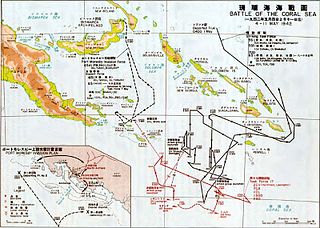
Operation Mo or the Port Moresby Operation was a Japanese plan to take control of the Australian Territory of New Guinea during World War II as well as other locations in the South Pacific with the goal of isolating Australia and New Zealand from their ally the United States. The plan was developed by the Imperial Japanese Navy and supported by Admiral Isoroku Yamamoto, the commander-in-chief of the Combined Fleet. The operation was ultimately abandoned.
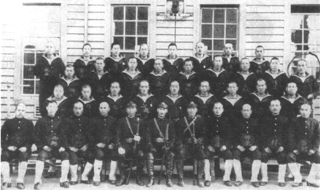
The invasion of Tulagi, on 3–4 May 1942, was part of Operation Mo, the Empire of Japan's strategy in the South Pacific and South West Pacific Area in 1942. The plan called for Imperial Japanese Navy troops to capture Tulagi and nearby islands in the British Solomon Islands Protectorate. The occupation of Tulagi by the Japanese was intended to cover the flank of and provide reconnaissance support for Japanese forces that were advancing on Port Moresby in New Guinea, provide greater defensive depth for the major Japanese base at Rabaul, and serve as a base for Japanese forces to threaten and interdict the supply and communication routes between the United States and Australia and New Zealand.

Nishizō Tsukahara, was an admiral in the Imperial Japanese Navy during World War II.
Sadayoshi Yamada was a Vice Admiral in the Imperial Japanese Navy during World War II.
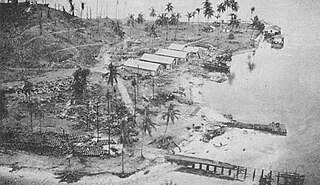
Tanambogo is an islet in the Central Province of the Solomon Islands. It is one of the Florida Islands.

The Marshalls–Gilberts raids were tactical airstrikes and naval artillery attacks by United States Navy aircraft carrier and other warship forces against Imperial Japanese Navy (IJN) garrisons in the Marshall and Gilbert Islands on 1 February 1942. The Japanese garrisons were under the overall command of Vice Admiral Shigeyoshi Inoue, commander of the 4th Fleet. Japanese aircraft in the islands belonged to the IJN's 24th Air Flotilla under Rear Admiral Eiji Gotō. The U.S. warship forces were under the overall command of Vice Admiral William Halsey, Jr.

The Tainan Air Group was a fighter aircraft and airbase garrison unit of the Imperial Japanese Navy (IJN) during the Pacific campaign of World War II. The flying portion of the unit was heavily involved in many of the major campaigns and battles of the first year of the war. The exploits of the unit were widely publicized in the Japanese media at the time, at least in part because the unit spawned more aces than any other fighter unit in the IJN. Several of the unit's aces were among the IJN's top scorers, and included Hiroyoshi Nishizawa, Saburō Sakai, Junichi Sasai, Watari Handa, Masaaki Shimakawa, and Toshio Ōta.

The Kisarazu Naval Air Group was an aircraft and airbase garrison unit of the Imperial Japanese Navy Air Service during the Second Sino-Japanese War and the Pacific campaign of World War II.
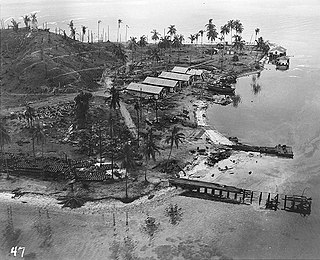
RAAF Tanambogo was a Royal Australian Air Force seaplane advanced operating base on the islands of Tanambogo, Gaomi and Gavutu constructed in 1939. Tanambogo and Gavutu were connected by causeway.
